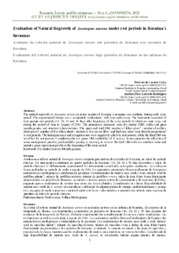Evaluation of Natural Regrowth of Axonopus aureus under rest periods in Roraima's Savannas.
Evaluation of Natural Regrowth of Axonopus aureus under rest periods in Roraima's Savannas.
Autoria: COSTA, N. de L.; RODRIGUES, A. N. A.
Resumo: The natural regrowth of Axonopus aureus in native pasture of Roraima ́s savannas was evaluate, during early rainy period. The experimental design was a completely randomized, with four replications. The treatments consisted of four pasture rest periods (14, 28, 42 and 56 days after beginning of the rainy period). Evaluations were carry out during the period of June to August of 2016. The parameters measured were dry matter (DM) yields and grass morphogenetic and structural characteristics. The green and total DM, number of tillers plant-1, number of axillary tillers plant-1, number of live tillers plant-1, number of live leaves tiller-1 and leaf area index were directly proportional to rest periods. The leaf appearance and elongation rate were negatively affect by rest periods, while the dead DM was not affect by rest periods. Considering the low green DM availability of A. aureus, its recommends the utilization of some management practice, preferentially grazing or mowing, to remove the dead DM with low nutrition value and permit a grass vigorous regrowth in the beginning of the rainy period.
Ano de publicação: 2021
Tipo de publicação: Artigo de periódico
Unidade: Embrapa Roraima
Palavras-chave: Dry matter, Leaves, Morphogenesis
Observações
1 - Por padrão são exibidas publicações dos últimos 20 anos. Para encontrar publicações mais antigas, configure o filtro ano de publicação, colocando o ano a partir do qual você deseja encontrar publicações. O filtro está na coluna da esquerda na busca acima.
2 - Para ler algumas publicações da Embrapa (apenas as que estão em formato ePub), é necessário ter, no celular ou computador, um desses softwares gratuitos. Sistemas Android: Google Play Livros; IOS: iBooks; Windows e Linux: software Calibre.
Acesse outras publicações
Acesse a Base de Dados da Pesquisa Agropecuária (BDPA) para consultar o acervo completo das bibliotecas da Embrapa.

